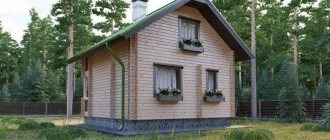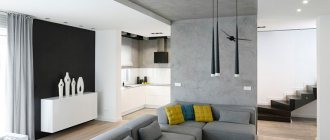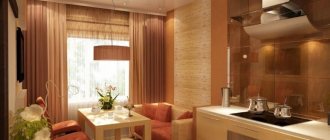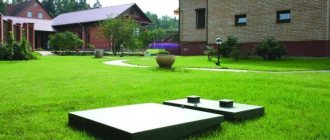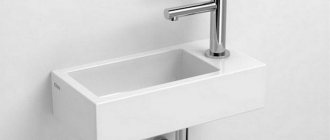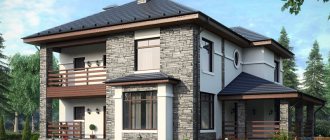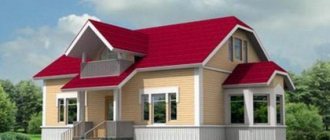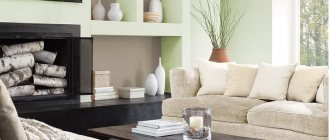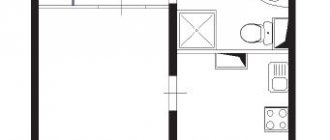Improving your apartment, making the space more economical and practical - isn’t this what every housewife or owner strives for?
Separate laundry room, equipped with everything you need - it’s very convenient!
A separate laundry room in the apartment has the following advantages:
- Convenience. A dryer on the balcony, a washing machine in the kitchen, and all the bathroom accessories in the bedroom - this does not add convenience. Grouping all of these things into one small room will make tidying up your home more enjoyable.
- Space saving. If all the things needed for washing and drying are located together, this will significantly increase the space in the remaining rooms.
- Aesthetics. Without ironing boards and dryers located throughout the apartment, the apartment will look more comfortable.
Minimum required premises in the house
Based on our experience and common sense, we recommend providing at least the following premises in the house:
- bedroom
- kitchen-dining room
- bathroom
- hallway.
If the size of the house allows (from 100 square meters), then we also recommend taking into account in the project:
- living room
- dressing room / pantry
- Utility room.
Other rooms can be provided in the house based on the wishes and capabilities of its owner.
What you need to set up a laundry room
Let's move on to equipping the laundry room. What equipment and additional equipment to place in the home laundry room is decided by each owner independently, depending on the needs of his family. As a rule, the home laundry room contains:
turnkey bathhouse in Bryansk inexpensive
The washing machine can be horizontal or vertical loading, it all depends on your preferences and the dimensions of the room. If you plan to install a countertop above the washer and dryer, then the first option is preferable. The power and size of the equipment depend on the size of your family and the size of the room.
Source
An example of a universal 10 by 10 house layout for permanent residence
What is convenient about this 10 by 10 house layout?
First floor:
Entrance through a small porch (2 m²).
Tambour - 2.27 m² (room for heat regulation of air from the street). On the left along the wall there is a place for a hanger - here we leave outerwear and shoes in which the owners have just arrived and are about to go again (for example, you are taking care of the garden and came in for something for a minute, the children are walking and came to drink water, etc. .). On the right is the boiler room. It's convenient that it's close to the entrance. Plus there is access from home (no need to get dressed and go outside). The plan shows the opening of the door, the door is always closed, there is often no need to go to the boiler room.
Corridor. On the left at the entrance there is space for a bedside table/shelf for a purse and keys. Along the right wall there are wardrobes with sliding doors. In the center of the closet there is a passage to the dressing room. Fur coats/coats that are actively worn this season are hung in these wardrobes (sections on the left and right). The dressing room (6.86 m²) stores clothes and shoes from other seasons. You can also leave the clothes of a large number of guests in it if they all came to the event at once.
What should be in the laundry room?
- Washing machine, as well as dryer, if space and funds allow.
- Sink: for hand washing, hand and shoe washing.
- Clothes dryer. This could be a mobile folding dryer familiar to our apartments, a stationary dryer mounted on the wall, separate modules for drying knitwear and linen, and hangers for drying delicate items.
- Ironing board (mobile or built-in)
- Laundry baskets: there can be several of them, which allows you to immediately sort dirty items by color and material, saving time in the future.
- Shelves and cabinets for detergents, rags, brushes.
- Niches and cabinets for an iron, vacuum cleaner, buckets, basins.
- Drying cabinet. If space and finances allow, you can install even such a miracle of technology in the laundry room. This cabinet dries clothes and removes odors thanks to built-in ventilation and air circulation (hot or cold).
- TV, radio: if the laundry room is equipped with an ironing board, most likely you will spend a lot of time here. Take care of your comfort and leisure by placing a small TV in the utility room.
Laundry room decoration
The design of this room should be worked out at the stage of creating the project. Functionality comes first here, so the design should be very utilitarian.
Helpful Tips:
- Think in advance about what kind of washing machine you want to install - its size, type of load, size and opening angle of the door are important. If you are planning to install a drying machine, then consider those models that will be combined with the washing machine according to the main parameters. Ideally, at the design stage it is worth choosing specific models - this will help to fit them perfectly into the existing room.
- If you want to place the dryer above the washing machine, you need to use a special rack that can withstand the upcoming loads. Here, not only the weight of the equipment is important, but also its “behavior” during operation - the stand must withstand the vibration created by the machines. The use of homemade systems consisting of brackets and corners is strictly prohibited, as this can lead to an accident and large-scale unplanned repairs.
- Provide enough shelving for laundry baskets. If your family tends to sort it by color, type of fabric, or other categories, organize special baskets for this and label them. Such a simple system helps to quickly teach all household members to immediately sort things and put them where they will be washed. This makes life much easier and saves time. For the younger generation, this habit will be especially useful: children from an early age learn to keep their wardrobe and home in order, which will be very useful in the future.
- If you have things that cannot be dried in a dryer, or there is no such device at all, you need to provide a structure for drying clothes in the laundry room. These could be ropes under the ceiling, railings, or something else with similar functionality. Here you need to focus on the family’s wardrobe and the features of caring for it. For example, it is convenient to hang some items damp on hangers straight from the washing machine, and then you don’t even have to iron them.
- If you have space in your laundry room for an ironing station or steamer, that's great. It will be possible to immediately put clean clothes in order right here, without taking them all over the apartment.
- Don't forget to provide ventilation to prevent mold from growing in the room. The system is simple, like in ordinary bathrooms.
- It is very advisable to install a sink for washing hands, shoes, and quick washing of small items. This will greatly facilitate the process of caring for the entire family’s wardrobe and help make the process as hygienic as possible.
- Provide a place right next to the washing machine to place baskets or basins from which things will be transferred to the wash and back. It is not always convenient to use only shelves and racks for this. There should also be at least 1 m2 on the floor for “transit” containers.
- If, after following all these recommendations, there is still a place that can be decorated somehow beautifully, use it to place additional lamps and fragrances. They will never be redundant.
Where to place the laundry room?
If you live in a private house, the ideal place for a laundry room may be a heated basement, understairs or attic. Be sure to ensure good ventilation. It is ideal if the utility room has a window for quick ventilation.
If you are the owner of a city apartment that does not have extra square meters, you can equip a laundry area in the bathroom or kitchen. In this case, you can hide the washing machine, baskets and detergents behind beautiful facades so that the utility unit does not stand out from the background of the apartment’s interior. Niches, deep cabinets and a dressing room are perfect for the same purposes. At the same time, household supplies can be placed on the cabinet doors to save space.
Storage options for household chemicals and laundry
To save space, there are many hangers, cabinets and shelves where you can put absolutely all household supplies:
- Household chemicals can be placed in fabric pockets on the laundry room wall or door. This is very convenient, since any product is in sight and always at hand.
- For such little things as sponges and rags, various boxes are produced, from small to large, with many compartments. Thanks to them, small things do not lie all over the room.
- Protrusions on the walls and niches can be used for shelves.
- Towels can be stored on special stands or on hangers on the wall.
- In the pull-out cabinets, you can allocate space for linen and household chemicals.
- For more rational use of pull-out cabinets, use dividers.
- If the laundry room is located in the bathroom, shelves can be placed directly above the toilet, thereby taking up the entire space.
When choosing a storage system, you should give preference to modular options that allow you to assemble the package “for yourself”
Finishing and decor of the room
Few people bring a lot of pleasure to household chores. As a rule, this is a boring and not the most pleasant pastime. The utility room should not only be comfortable, but also beautiful, then household chores will become much more enjoyable for you. Hang bright posters and photographs, cover the walls with stylish wallpaper or paint them in your favorite color, choose cute laundry baskets, boxes for small items, and pour cleaning products into beautiful bottles. Create a comfortable atmosphere for yourself, and three hours of ironing will fly by!
How to organize a utility room in an apartment
For many people, the laundry room or utility room becomes as integral a part of the interior as the dressing room. Allocating a separate corner or (if available) a room for household needs will help bring order to the house and relieve pressure on other rooms.
Rid all your cabinets and corners of buckets, rags, cleaning products, conveniently placing it all in the laundry room (alcove or closet). Today we will tell you how to organize the perfect laundry room at home.
Currently reading:
A city dweller has a hard time imagining life in a country house: he really doesn’t understand that the rooms in a house can have different functionality. In a typical city apartment, a family has two or three rooms, a kitchen, a bathroom, a hallway and, if they are lucky, a small storage room. And when it comes to building a country house, the city dweller is lost: after all, all dreams can be realized: a library with a fireplace, a gym, a cinema hall... But during the operation of the house, a hangover often occurs. It turns out that some premises could be done without, but some are sorely lacking! This article tells you what the composition of premises in a private house should be.
- What rooms should be in a private house
- Features of designing the premises of a small private house
- Features of designing premises of a medium-sized private house
- Features of designing premises of a large private house
- Recommended area of the house
There is no room for categoricalness in the matter of planning the premises of a private house. A country house is built for a comfortable life, and it should be comfortable for those who will live in it. Not a single architect will say that any country house should have so many rooms, while the kitchen should have this area, and the guest bedroom should have this area. The ergonomics of premises is based on a number of data, including human parameters.
What rooms should be in the house
For modern houses, architects (with various reservations) recommend determining the composition of the premises of a private house based on the functional purpose of its different zones. All premises of a private house are divided into three zones:
And they are already divided into night and day zones. This cheat sheet will help you determine which rooms are needed in a private home.
| Zone | Residential | Economic | Entrance |
| Day stay is located on the ground floor. Includes rooms for adults, children, and guests. | Hall; Living room; Dining room; Cabinet; Children's playroom; Toilet; Veranda; Billiard room; Gym; Wardrobe for outerwear. | Kitchen. Boiler room (in the lower floor or basement). Laundry. Pantry (always next to the kitchen). workshop. garage. | The first entrance is from the entrance to the site, if the house is not in the south, a vestibule is highly desirable. The second exit is either to the terrace (from the living room or dining room) or for household needs. |
| Overnight stays are often located on the second floor. | Bedrooms and auxiliary premises (bathroom, dressing rooms). | — | — |
For a comfortable life in a private house, it is better to immediately provide for:
- so that each adult family member has his own room;
- so that the premises of adult family children and their parents are divided into different zones; ideal if with separate entrances;
- that it is better to functionally combine and make some rooms passable than to arrange corridors. Rooms in a house should connect to rooms;
- if guests come several times a year, a guest bedroom is not needed: they can spend the night on the sofa in the living room;
- room for washing, drying and ironing. The need to constantly take an ironing board out of the pantry becomes a real stress for many, when it is constantly standing in a special room, disassembled, and there is an opportunity to accumulate stacks of clean linen there before ironing, this greatly improves the quality of life;
- the maximum possible number of storage rooms and dressing rooms.
The more storage rooms and dressing rooms, the better, the more free the rooms - living spaces - will be. It is good to place them in the corridors, because we rarely use many things or their use is seasonal. Expand the corridor by 60 cm and the space for built-in wardrobes is ready, and the corridor will no longer be a useless place.
According to the experience of our users, who have built and lived in their houses for enough time to draw conclusions, a two-story house needs at least two storage rooms: on the ground floor for storing skis, snowboards, a vacuum cleaner, tools, extension cords; on the second - seasonal clothes and shoes, blankets, a collection of old magazines, etc.
Setting up a laundry room in the house
Regardless of how much time we spend at home, each of us wants this place to be as comfortable and cozy as possible.
Often, when arranging our home, we forget about organizing auxiliary rooms: a dressing room, pantry or laundry room. And if recently the first two have become more and more firmly integrated into our everyday life, then the laundry room is unreasonably not given due attention. Why do you need a separate laundry room in the house? The answer is simple: the laundry room, or laundry room, unloads the rest of the space in the room, makes it more comfortable, functional and generally makes life easier for the owners. In addition to the washing machine and dryer, dryers and ironing board with iron, laundries can accommodate storage systems for linen and household chemicals, as well as equipment and cleaning equipment. Let's look at this issue in more detail below.
Composition of the premises of a private house according to SNiP
The minimum composition of the premises of a one-apartment house is regulated by the current SNiP 02/31/2001 “Single-apartment residential houses”. According to this document, a private house must have at least the following premises:
- living room (or living rooms;
- kitchen (or kitchen-niche, or kitchen-dining room;
- front (hallway, hall);
- bathroom or shower;
- restroom;
- pantry (or built-in wardrobes);
- boiler room (in the document it is written as follows: “in the absence of centralized heating supply, a room for a heating unit.”
Everything else - what rooms will be in the house, how they will be connected to each other - is determined by the developer, based on the composition of the family, lifestyle, needs and wants.
We are already building a second house. The operation of the first house showed that the guest room was used at best 2-3 times a year, but there was a catastrophic lack of storage space in the entrance, kitchen and laundry room. And it is also very desirable to have a vestibule; in summer, shoes can be taken off there and the house is cleaner, and in winter, the vestibule protects from the cold. And a pantry in the kitchen will save money on furniture (fewer cabinets are needed), and a food processor, large pots and a supply of food are perfectly located there!
SNiP establishes the following requirements for the minimum area of premises:
| Premises of a private house | Minimum room area (m2). |
| Shared living room | 12 |
| Bedroom | 8 |
| Bedroom in the attic | 7 |
| Kitchen | 6 |
Construction design of private house premises according to Neufert
For anyone who is planning to design a house on their own, experts strongly recommend reading the book “Building Design” by the German architect and outstanding architectural theorist Erns Neufert. One of its publications is freely available on the Internet. FORUMHOUSE users posted on our portal scans of pages necessary for planning premises. The book was written in the years when the minimalist approach dominated in house building. Everyone strived to create optimally sized and maximally functional premises.
This approach is now partly outdated; you need to remember that all the recommendations from the book are given for people of average height and weight, and that it provides the minimum dimensions of rooms, furniture, and distances between objects. More is possible, less is not possible.
I selected furniture for the kitchen based on Neufert's standards. This was a new level of comfort for me.
How to properly care for the plumbing installation in your laundry room?
The correct connection of equipment to the home sewer system is of great importance. The laundry room must be equipped with a drain. This way you will protect yourself from uncontrolled spills of water from the washing machine and flooding of laundry. The drain grate will cause water to drain into the drain. Ideally, a laundry room should be included during the planning stage of your home.
Additional items in the laundry room
Sometimes a sink is installed. It is convenient to immediately wash your hands after contact with dirty clothes. A cabinet for storing household chemicals, or shelves for ironed linen. But everyone is free to place whatever their heart desires in such a room. Perhaps flowers or paintings. The laundry room in the house is a functional room that will maintain order in other rooms. Properly designed, it will certainly meet the expectations and needs of all household members.
Small house according to Neufert
Small one-apartment house “according to Neufert”:
- must consist of rooms with dimensions of the minimum acceptable dimensions;
- the furniture in them is arranged as rationally as possible;
- zones with different functionality are combined in one room. The kitchen can be combined with a dining room, or a niche for cooking can be provided in the living room, etc.;
- A small number of spacious rooms and a small hall are better than many small “cages”.
With this approach, one-story houses are preferable (you won’t have to waste the house’s space on stairs). If the house is still two-story or with an attic, the staircase in it always occupies a minimum area and is located with maximum benefit - for example, a stairwell can be a barrier to the cold tending to penetrate into the rooms.
Where did the construction recommendations come from for the width of the stairs in a private house to be at least 90 cm? We take the book “The Overseas Enemy” by Neufert: passages between walls with hand luggage. With a small amount of luggage, the minimum distance is 800 or 875. That's where 90 cm comes from. In a private house, a staircase width of 80 cm is allowed, although it is clear that this is not so convenient. Therefore, if the dimensions allow, then it is better to make a staircase with a width of 120 cm, or even 135 cm. With limited dimensions, no less than 90 cm. This, by the way, is the width without fencing.
The architect emphasizes that although a square house is more economical than a rectangular one, a rectangular one may turn out to be more convenient (very often on narrow plots).
Choosing a washing machine size
The central place in the laundry room is occupied by the washing machine. Therefore, it is important to choose functional and compact equipment.
The dimensions and number of household appliances in the laundry room largely depend on the needs of your family
The size of the washing machine depends on where it will be located and how large your family is. You can choose from the following types of washing machines:
- Top loading machine. Suitable for installation in the bathroom. They are convenient because the laundry is loaded from above and there is no need to bend over. The average dimensions of such machines are: height 90 cm, depth 60 cm.
- Front loading machine. The most popular type of washing machines. Standard sizes: height 85-90 cm, depth from 40 to 80 cm.
- Machine for installation under the sink. This is the smallest version of a washing machine, their height is about 60 cm and their depth is no more than 55 cm. This is done for convenience and so that the machine does not protrude beyond the boundaries of the sink.
- Machine for installation under the countertop. Built-in machines have a shallow depth. And the height is selected in such a way that there is a free distance between the tabletop and the machine. Such machines usually have a loading capacity of 7 kg.
Medium-sized house according to Neufert
In a medium-sized house, it is recommended to separate the bedrooms and combine rooms with similar functionality: for example, a kitchen and a living room with a dining area, or even a kitchen, living room and hall. It is important here that the relationships between the rooms are convenient.
Big house according to Neufert
Large houses are distinguished by the possibility of insolating the premises at exactly the right time of the day (for example, you can arrange bedrooms on the eastern side of the house) and the ability to arrange volumes that consist of several floors. Here comfort comes to the fore: if the owner plans to throw parties, you can provide a dance floor and a bar; if the owner prefers a constructive and creative lifestyle to an idle lifestyle, then a workshop and study. But the above projects show how reasonable and functional everything is: utility rooms are conveniently located next to the additional entrance, children's rooms are as far away from the dance floor as possible, and the pantry serves as a buffer between the kitchen and dining room.
Summarizing
When determining how many rooms there should be in a private house, designers often use the formula: number of permanent residents +1. This is a rough formula, but it can be easily adapted to a specific family: you have or are planning to have small children - in a few years they will need separate rooms. Relatives or friends stay for a long time - they need somewhere to sleep. The owner works at home - he needs an office. The housewife is obsessed with sports - it is better to give her a separate room for this. It is already difficult for parents to live alone - it is necessary to provide them with a comfortable room with a close bathroom.
When planning the premises of your future home, you need to imagine your life in 10-15 years.
It is also necessary to adhere to the following room sizes (anything less is no longer comfortable).
Recommended area of the house
| Living room | 25-30 sq. m. |
| Dining room | 15-20 sq. m. |
| Kitchen | 12-16 sq. m. |
| Bedroom for a child with one bed | 12-15 sq. m. |
| Double bedroom | 14-25 sq. m. |
| Bathroom | 6-10 sq. m. |
| Dressing room or storage room | 2-3 sq. m. |
| Hallway | 5-8 sq. m. |
| Cabinet | 12-15 sq. m. |
Corridors, halls, stairs add another 10-15% of the total area of the rooms.
On FORUMHOUSE you will find information that will help you design your own home, a fascinating discussion of the principles of rational planning, as well as any current issues regarding home planning. Read a useful article about the features of the layout of a private house, watch a video about an unusual and functional house design.

